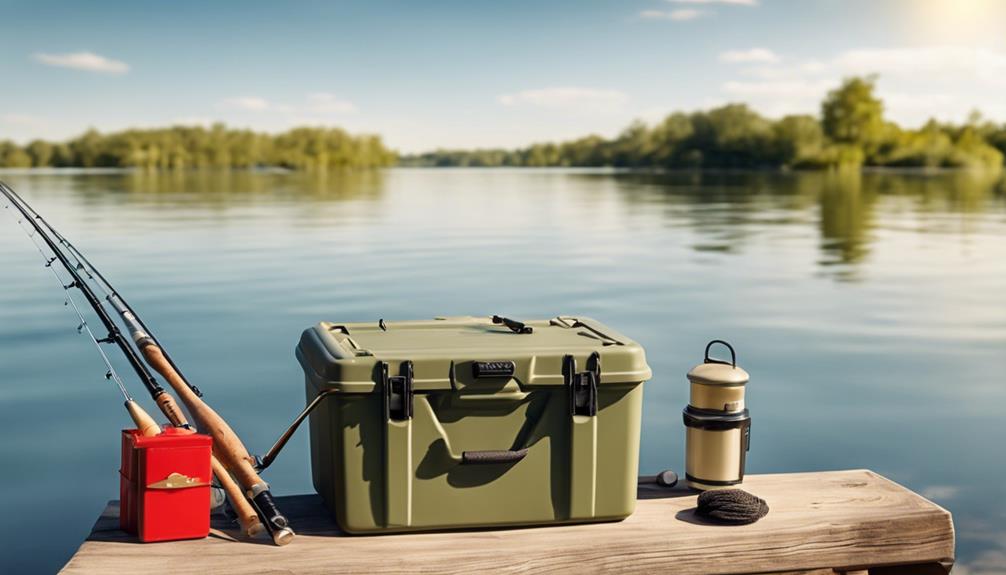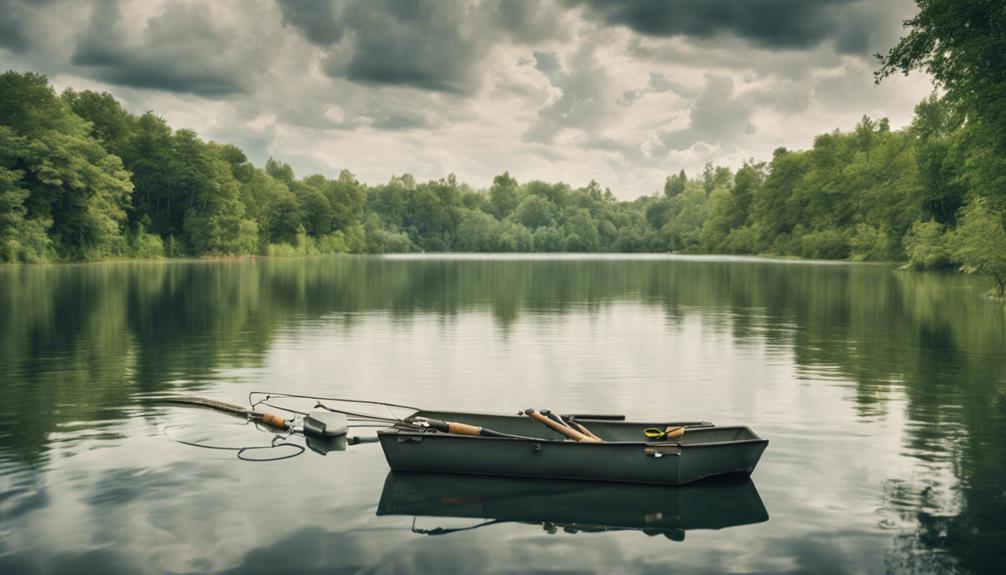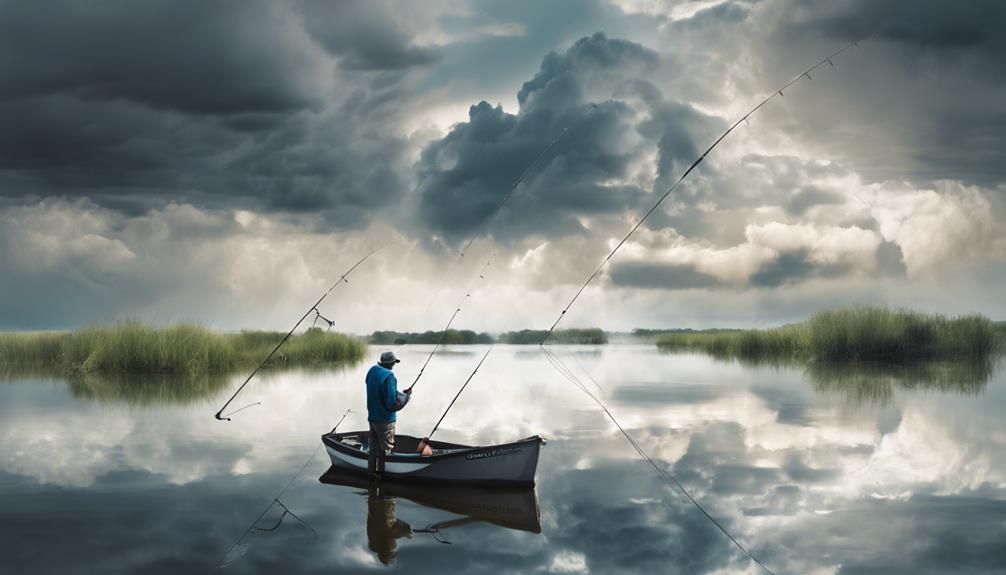For optimal fishing conditions, focus on sunny skies for better visibility and use reflective lures. Light breezes parallel to shore attract fish, while stable barometric pressure indicates consistent weather and reduces fish stress. Overcast days trigger fish activity and mild temperatures increase fish movement towards the surface. Consistent cloud cover reduces sunlight penetration, moderates water temperatures, and triggers insect hatches. These six weather conditions contribute to successful fishing trips, enhancing your chances of a great catch. Discover how each element impacts your angling success for more fruitful outings.
Sunny Skies
When fishing, sunny skies provide optimal visibility and can enhance your chances of a successful catch. Fishing techniques under these conditions should focus on using lures that reflect light well, such as spoons or spinners, to attract fish effectively. Gear selection becomes critical during bright days; polarized sunglasses can help reduce glare off the water, allowing you to see beneath the surface and spot fish more easily. Additionally, choosing lighter colored lines can make them less visible to fish in clear, sunny waters.
Location scouting plays a significant role in sunny weather. Fish tend to seek shelter in shaded areas to avoid the direct sunlight, making structures like docks, overhanging trees, or underwater vegetation prime spots for fishing. Understanding fish behavior in sunny conditions is key to a successful fishing trip. Predatory fish might become more active in the early morning or late afternoon when the sun isn't as intense, while others may move to deeper waters to escape the heat during the middle of the day.
Light Breezes
Light breezes can have a significant impact on your fishing experience, affecting various aspects such as casting accuracy and fish behavior. When considering wind direction, it's crucial to note that light breezes blowing parallel to the shore can create optimal conditions for fishing. This type of wind aids in pushing baitfish towards the shore, attracting larger predatory fish closer to where you're casting. On the other hand, winds blowing directly from the shore can disrupt the water's surface, making it harder for fish to see your bait and resulting in decreased fishing success.
In terms of water clarity, light breezes play a key role. Gentle winds help maintain a certain level of water clarity by preventing sediment from being stirred up and clouding the water. This improved visibility can lead to better fishing outcomes as fish are more likely to spot and go after your bait. However, it's important to note that if the water is too clear, fish may become more cautious and wary of approaching bait.
Stable Barometric Pressure
Stable barometric pressure plays a crucial role in influencing fish behavior and feeding patterns during fishing expeditions. When the barometric pressure remains steady, it indicates consistent weather conditions, which can lead to more predictable fishing outcomes. Fish are sensitive to changes in pressure, and stable conditions are generally preferred for successful fishing trips.
One key aspect affected by stable barometric pressure is fishing pressure. During stable conditions, fish are less stressed and more likely to exhibit natural feeding behaviors. This can result in increased feeding activity and higher chances of a successful catch.
Additionally, stable barometric pressure can have a significant impact on tidal movements. Tides are influenced by atmospheric pressure, and when the barometric pressure is stable, tidal patterns tend to be more regular. This predictability can help anglers plan their fishing expeditions more effectively, aligning their fishing times with optimal tidal movements for better results.
Overcast Conditions
Optimal fishing conditions can be influenced by the presence of overcast skies. When considering overcast conditions, anglers often associate them with rainy days and adjusted fishing techniques. Rainy days can be beneficial for fishing as they can trigger fish to be more active and feed more aggressively. During these conditions, it's advisable to use lures or baits that create more vibration or noise to attract fish in the lower light conditions of overcast skies.
Moreover, overcast skies are often accompanied by foggy mornings, which can provide excellent opportunities for anglers. Fog tends to disorient fish, making them more likely to strike at bait. When faced with foggy mornings, using the best baits is crucial. Topwater baits such as frogs or poppers can be highly effective during these conditions as they create commotion on the water's surface, making them more visible and enticing to fish.
Incorporating these strategies into your fishing routine during overcast conditions can significantly increase your chances of a successful day on the water. By adjusting your techniques to suit the lower light levels and taking advantage of fish behavior changes induced by rainy days and foggy mornings, you can optimize your fishing experience when faced with overcast skies.
Mild Temperatures
Mild temperatures can significantly impact fish behavior and feeding patterns, influencing the success of your fishing expedition. When the weather is mild, it generally indicates stable atmospheric conditions, which can lead to increased fish activity. On rainy days, fish tend to move closer to the surface, creating opportunities for anglers to target them more effectively. This behavior is attributed to the decrease in sunlight penetration caused by cloud cover and rain, making fish more comfortable in shallower waters.
Cold fronts, on the other hand, can disrupt the mild temperatures and impact fish behavior. As a cold front approaches, the barometric pressure drops, signaling to fish that a change in weather is imminent. This can lead to decreased feeding activity as fish tend to become more cautious and retreat to deeper, more sheltered areas. However, understanding these patterns can help you adjust your fishing strategies accordingly.
When faced with mild temperatures, it's essential to adapt your fishing techniques to capitalize on the conditions. Using lighter tackle and presenting baits more subtly can often yield better results. Additionally, being observant of changes in fish behavior in response to weather fluctuations can give you a competitive edge when out on the water. By staying attuned to these nuances, you can enhance your fishing experience and increase your chances of a successful outing.
Consistent Cloud Cover
Consistent cloud cover plays a crucial role in influencing fish behavior and feeding patterns during fishing expeditions. When it comes to fishing productivity, cloud coverage is a significant factor to consider. Cloudy days often lead to increased fishing success due to the impact they've on the underwater environment.
Cloud cover can help create favorable conditions for fishing by reducing the amount of sunlight that penetrates the water. This subdued lighting can make fish feel more secure and less exposed, encouraging them to venture out and feed more actively. Additionally, clouds can moderate water temperatures by blocking some of the sun's heat, preventing sudden temperature fluctuations that might spook the fish.
Moreover, consistent cloud cover can also trigger hatches of aquatic insects, a vital food source for many fish species. The reduced light and increased humidity from cloudy conditions create an ideal environment for insect activity, attracting fish to the surface to feed.
Studies have shown that on days with consistent cloud cover, fish tend to be more scattered throughout the water column, offering anglers a higher chance of success. The diffusion of light under cloudy skies can also make lures or bait appear more natural and enticing to fish, further enhancing the fishing experience. Therefore, when planning your next fishing trip, keep an eye on the cloud cover forecast for potentially improved fishing conditions.
Frequently Asked Questions
How Do Lunar Phases Affect Fishing Success?
When it comes to lunar phases and their impact on fishing success, understanding the relationship between moon phases and angling techniques is crucial.
Various lunar cycles can significantly influence the behavior of fish, affecting their feeding patterns and activity levels.
By aligning your fishing strategies with specific moon phases, you can enhance your chances of a successful catch.
Paying attention to these factors can lead to improved angling success and a more fruitful fishing experience.
What Role Does Water Clarity Play in Fishing?
When considering the role water clarity plays in fishing, visibility is key. Temperature variations can impact this clarity, affecting aquatic life behavior.
Rainfall can also influence water clarity, potentially altering fishing conditions. Understanding how these factors interact can help you adapt your fishing techniques for varying water conditions.
Keep an eye on water clarity to optimize your chances of a successful fishing outing.
Does the Time of Day Impact Fish Activity?
When it comes to fish activity, the time of day does indeed have a significant impact. Morning bites are typically more active periods where fish are actively feeding, while evenings often see a decrease in activity, known as evening lulls.
These patterns can be influenced by factors such as light levels, temperature changes, and prey availability.
Understanding these fish behavior trends can help you plan your fishing trips more effectively to increase your chances of success.
Can Tides Influence Fishing Outcomes?
Tidal patterns play a crucial role in fishing outcomes. Understanding tidal movement is key to developing effective strategies.
Different techniques can be employed based on whether the tide is incoming or outgoing. During certain phases of the tide, fish tend to be more active, making it an optimal time for fishing.
Are Certain Bait Types More Effective in Different Weather Conditions?
When considering bait selection, weather conditions play a crucial role in your fishing success. Different types of bait may be more effective depending on the prevailing weather conditions.
Temperature fluctuations can impact the behavior of fish, influencing their response to specific bait types. By understanding how weather conditions affect bait effectiveness, you can adapt your fishing strategy to optimize your chances of a successful catch.
Conclusion
In conclusion, optimal fishing conditions include:
- Sunny skies
- Light breezes
- Stable barometric pressure
- Overcast conditions
- Mild temperatures
- Consistent cloud cover
These weather conditions create an environment conducive to successful fishing outings, allowing for better visibility, calmer waters, and increased fish activity.
By monitoring these factors and planning your fishing trips accordingly, you can maximize your chances of a successful and enjoyable fishing experience.



